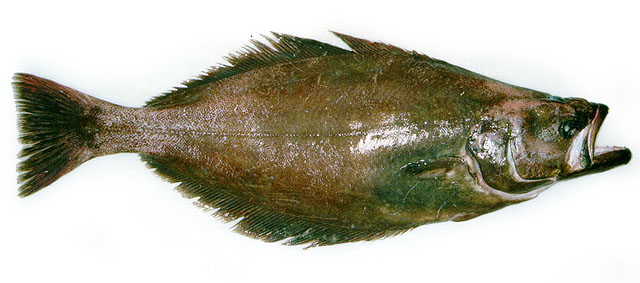| Pleuronectidae (Righteye flounders), subfamily: Hippoglossinae |
| 110 cm TL (male/unsexed); 130 cm TL (female); max.weight: 7,000.0 g; max.weight: 45 kg; max. reported age: 36 years |
|
benthopelagic; marine; depth range 1 - 2200 m, oceanodromous |
| Circumglobal: In arctic and temperate waters; northern hemisphere. Sea of Japan off Honshu north to Shishmaref, Alaska in the Chukchi Sea, throughout the Aleutian Islands, and southeast to northern Baja California, Mexico. North Atlantic: New Jersey, USA to Spitsbergen (Svalbard Islands) and the Barents Sea south to Ireland. Northwest Atlantic: Canada (Ref. 5951). |
|
Dorsal spines (total): 0-0; Dorsal soft rays (total): 83-108; Anal spines: 0-0; Anal soft rays: 62-79; Vertebrae: 60-64. Dorsal origin behind posterior edge of upper eye. Caudal slightly forked to truncate. Pectorals small. |
| Often caught pelagically (Ref. 4705). Adults prefer bottom temperatures of -0.5°C to 6.0°C (Ref. 5951). Epibenthic (Ref. 58426). Feed on crustaceans, fishes (Ref. 4705, 6885), eelpouts, capelin, redfishes, deep sea prawns and other bottom invertebrates (Ref. 35388). Batch spawner (Ref. 51846). Utilized dried or salted and frozen; can be steamed and fried (Ref. 9988). Size of the Greenland halibut collected from 400-599 m deep in eastern Bering Sea, ranged from 9 to 99 cm FL with a mean of 56 cm (Ref. 55110). |
|
Near Threatened (NT); Date assessed: 24 February 2021 (A4bcd) Ref. (130435)
|
| harmless |
Source and more info: www.fishbase.org. For personal, classroom, and other internal use only. Not for publication.
